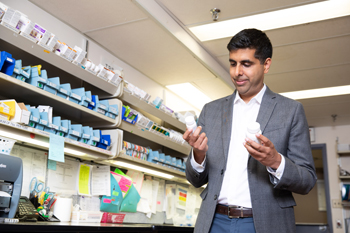Canadian and U.S. surgical patients filled opioid prescriptions at a rate nearly seven times higher than Swedish patients: study

By Jennifer Stranges

Dr. Karim Ladha
A new study published today in JAMA Network Open found that patients in Canada and the United States who underwent one of four low-risk surgical procedures filled opioid prescriptions within a week after discharge at a rate that was nearly seven times higher than patients in Sweden.
The study – which focused on adults who underwent gallbladder removal, appendix removal, meniscus repair and breast lump removal – is the first of its kind to systematically evaluate the differences in the use of opioids after surgery for patients receiving similar procedures in different countries.
About 76 per cent of the U.S. patients and nearly 79 per cent of the Canadian patients filled a prescription for opioids after their surgery versus just 11 per cent of Swedish patients.
Researchers found that patients in the United States received significantly higher doses of opioids compared to patients treated in Canada and Sweden. The findings were consistent for each of the four surgical procedures assessed.
“There is clear variability in the use of opioids after surgery in different countries,” says Dr. Karim Ladha, a clinician-scientist at the Li Ka Shing Knowledge Institute of St. Michael’s Hospital and co-author of the study.
“Opioids are routinely prescribed for postoperative pain management in many countries; however, the findings suggest the potential to re-evaluate prescribing practices internationally.”
Dr. Ladha said the findings point to the differences in preference and culture of patients and providers rather than actual need.
The study examined the frequency, amount and type of opioids dispensed after surgery and points to differences in practitioners’ approaches to opioid prescribing, public attitudes regarding the role of opioids in treating pain, and broader structural factors related to drug marketing and regulation.
Excessive postoperative opioid prescribing has been associated with increased risks of drug diversion, new long-term opioid use, and the development of opioid use disorder. In 2018, nearly 4,500 opioid-related deaths occurred in Canada.
This paper is an example of how St. Michael’s Hospital is making Ontario Healthier, Wealthier, Smarter.
About St. Michael’s Hospital
St. Michael’s Hospital provides compassionate care to all who enter its doors. The hospital also provides outstanding medical education to future health care professionals in more than 27 academic disciplines. Critical care and trauma, heart disease, neurosurgery, diabetes, cancer care, care of the homeless and global health are among the Hospital’s recognized areas of expertise. Through the Keenan Research Centre and the Li Ka Shing International Healthcare Education Centre, which make up the Li Ka Shing Knowledge Institute, research and education at St. Michael’s Hospital are recognized and make an impact around the world. Founded in 1892, the hospital is fully affiliated with the University of Toronto.
About Unity Health Toronto
Unity Health Toronto, comprised of Providence Healthcare, St. Joseph’s Health Centre and St. Michael’s Hospital, works to advance the health of everyone in our urban communities and beyond. Our health network serves patients, residents and clients across the full spectrum of care, spanning primary care, secondary community care, tertiary and quaternary care services to post-acute through rehabilitation, palliative care and long-term care, while investing in world-class research and education. For more information, visit www.unityhealth.to.
